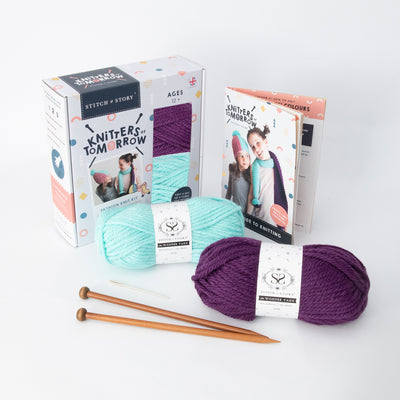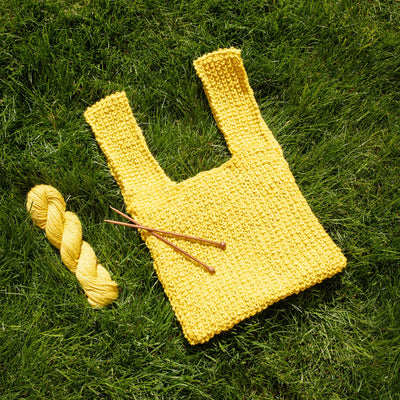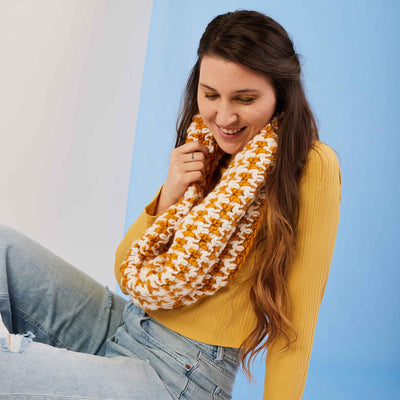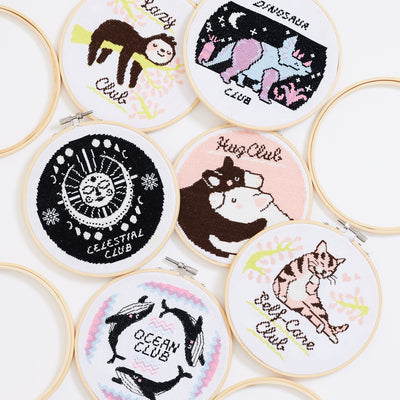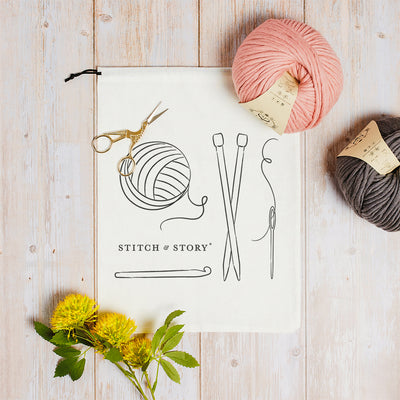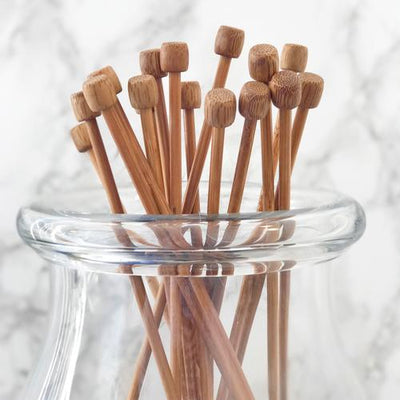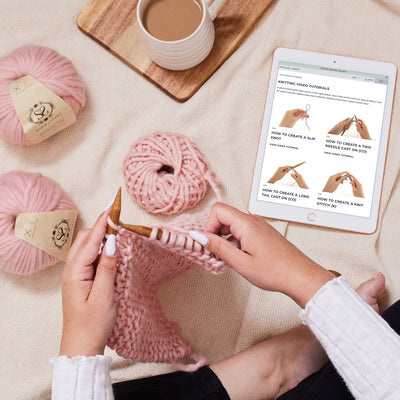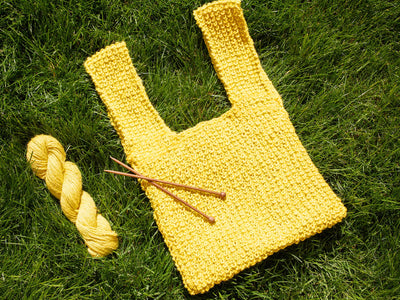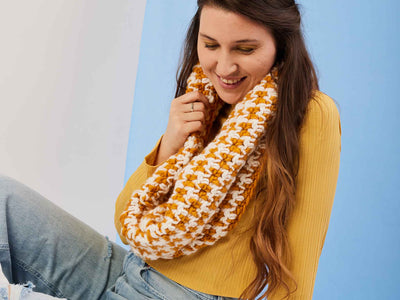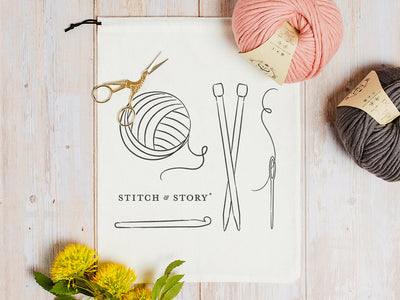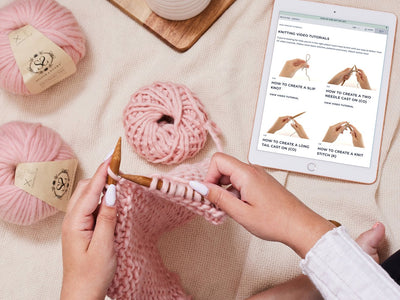
To Swatch Or Not To Swatch - The Importance Of Gauge
5 min read time
Hello crafters,
If you’ve read our Understanding Patterns And How To Read Them (Part 1) blog post or gone through any Stitch & Story pattern you will have seen mention of tension squares or gauge swatches. Often crafters will skip over this stage of a pattern but, while maybe not glamorous, a gauge swatch is an important part of any project. A simple practice run; the gauge swatch or tension square is an opportunity for you to test stitches and check that your finished item will end up the same size as indicated on the pattern.
If the finished size of your project doesn’t concern you then it is possible to skip the gauge swatch stage. Stitch & Story projects where exact size are less important, like the Chunky Tassel Throw, Mateusz Snood or Vale Scarf could be approached without checking gauge but just be aware of the possibility of running out of yarn. If you’re making anything fitted, such as the Pia Weekend Sweater, then it is worth taking the time to make a gauge swatch and ensure your sizing is perfect.
Grab yourself some yarns and tools, and let's get swatching!
BEGINNER’S GUIDE - HOW TO CROCHET/KNIT A GAUGE SWATCH
Gauge
Not all knitters or crocheters stitch alike. As well as different styles (such as English or Continental in knitting) that affect the way crafters hold their yarn, needles or hooks, everyone has their own tension. Some people’s stitches are tight, while others’ are looser. So how does a designer ensure that anyone can pick up their pattern and exactly reproduce it irrespective of knitting/crochet technique? With gauge.
Gauge is essentially a measurement of how big a stitch is, the width and height, and directly corresponds to tension. In a pattern, the gauge is the number of stitches per cm/inch created on the horizontal, and number of rows per cm/inch created on the vertical. The needle size, yarn weight and crafter’s tension all influence stitch size and altering just one of these variables will affect the pattern gauge.
Gauge swatch / tension square
So how does one measure a stitch? To check your gauge (or tension) before starting a pattern you knit/crochet a swatch (tension square). The standard gauge is 4 inches x 4 inches, or 10cm x 10cm. Following the gauge swatch instructions in your pattern - and using the recommended needle size and yarn - cast on (or create a foundation chain of) the number of stitches the gauge calls for and knit/crochet the required amount of rows. If knitting a swatch make sure you also cast off before measuring.
Lay your knit/crocheted swatch flat and measure its height and width. If your swatch is a 10cm x 10cm square then your gauge is correct for the pattern and you can start the project.

However, what do you do when your swatch doesn’t match the required gauge? It is difficult to alter how tightly you knit/crochet so if you find your completed swatch is smaller than 10cm x 10cm switching to a bigger needle/hook size may help you achieve the desired dimensions. If your swatch ends up bigger than 10cm x 10cm you may want to switch to a smaller needle/hook size. It is worth redoing your swatch a few times with different needle/hook sizes until you produce a 10cm x 10cm square.
If your first gauge swatch is only marginally smaller than required and switching to a bigger needle/hook size creates a swatch much larger than 10cm x 10cm stick with the original needle/hook size. Washing and/or blocking your knit/crocheted fabric will relax the stitch fibers so even if your finished project seems a little smaller than the pattern indicates you’ll often find it becomes the correct size after washing and/or blocking it.
If you’ve decided to use a different yarn than the pattern was designed for, you may find you have to test it with several needle/hook sizes before you produce a swatch that matches the pattern gauge.
TIP - Do not cut your gauge swatch off your ball of yarn. Once you have successfully achieved the correct gauge just unravel your swatch and reuse the yarn for your project. If you discard the yarn used for a swatch, particularly if you’ve made more than one, you may find you run out of yarn before your project is finished.

The importance of a gauge swatch / tension square
Often crafters want to skip the gauge swatch stage of a pattern in their eagerness to get started with the project but this is a really important step. You don’t necessarily have to match gauge but just be aware if you don’t there is no guarantee your finished item will end up as the designer intended. You may find it doesn’t quite fit, or even run out of yarn before finishing.
Sizing
One of the main reasons for gauge in a pattern is to ensure the finished measurements are as expected. If you’re knitting a pattern with multiple sizes, such as a sweater, you’ll need to match the gauge so that your stitch sizes, and resulting measurements, match those of the designer. Differences in tension mean multiple knitters/crocheters could all follow the same pattern, using the same yarn and needles, and end up with different sized sweaters. Making a gauge swatch allows you to account for these differences and end up with a finished item that fits.
Yarn - too much or too little
The yarn included in a Stitch & Story kit is the exact amount required to complete the pattern, based on the designer’s gauge. If your tension is looser - meaning you’re knitting/crocheting fewer stitches per inch than the pattern gauge - you’ll run out of yarn before you reach the end of your project. If your tension is tighter - meaning you’re knitting/crocheting more stitches per inch than the pattern gauge - you’ll have way more yarn leftover. By knitting/crocheting a gauge swatch you can identify if your tension is looser (your gauge swatch is bigger than 10cm x 10cm) or tighter (your gauge swatch is smaller than 10cm x 10cm) before starting and switch needle/hook size if necessary.
Overall look and feel
It’s not only fit and size that are affected by gauge. Stitches that are close together create a solid fabric, while looser stitches create more drape. A designer will choose how tight or loose the stitches in a pattern should be for a purpose. In addition to tension affecting the look and overall structure of the knit/crocheted fabric it can affect the warmth of a garment. For example, looser stitches will allow more air to circulate, which may be desirable in a summer top but less so in a winter hat.
Practice
Swatches give you a chance to get familiar with your yarn and needles/hook, and try out stitch patterns that will be used in the project, such as cables or lace. Remember practice makes perfect and any opportunity to test out new techniques before starting a project is good.
We know that gauge swatches can be tedious, especially when you just want to get stuck into the actual pattern, but taking the time to make a quick swatch before can avoid a lot of disappointment after. All of our Stitch & Story patterns recommend creating a gauge swatch, particularly if you are a beginner. Tension can fluctuate when you’re learning to knit or crochet so even if you’re not a complete beginner it’s worth doing a gauge swatch each time you return to a pattern; specifically if some time has passed since you last knit/crocheted that project.
Happy crafting!
